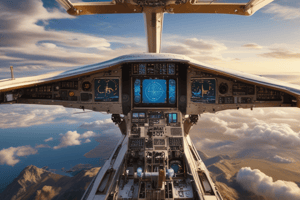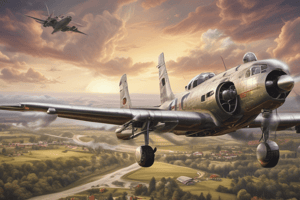Podcast
Questions and Answers
What is a primary concern with mechanical control systems?
What is a primary concern with mechanical control systems?
- System complexity and reliance on electrical power
- Pilot detachment from control surfaces
- Stretch or slack in cables (correct)
- Implementation of envelope protection
Which system is more prone to weight reduction?
Which system is more prone to weight reduction?
- Analog control systems
- Hybrid control systems
- Fly-by-wire systems (correct)
- Mechanical control systems
What is a safety feature that can be implemented in fly-by-wire systems?
What is a safety feature that can be implemented in fly-by-wire systems?
- Envelope protection (correct)
- Cable tension monitoring
- Pilot fatigue tracking
- Autopilot engagement
Why do pilots may feel 'detached' from the actual control surfaces in fly-by-wire systems?
Why do pilots may feel 'detached' from the actual control surfaces in fly-by-wire systems?
What is a key factor in the choice of control system in an aircraft design?
What is a key factor in the choice of control system in an aircraft design?
What promises to further enhance the functionality and reliability of aircraft control systems?
What promises to further enhance the functionality and reliability of aircraft control systems?
What is a disadvantage of mechanical control systems?
What is a disadvantage of mechanical control systems?
What is a characteristic of fly-by-wire systems that requires specialized knowledge?
What is a characteristic of fly-by-wire systems that requires specialized knowledge?
Why are pilots required to trust computer systems in fly-by-wire systems?
Why are pilots required to trust computer systems in fly-by-wire systems?
What is a commonality between mechanical and fly-by-wire control systems?
What is a commonality between mechanical and fly-by-wire control systems?
Fly-by-wire systems are heavier than mechanical systems.
Fly-by-wire systems are heavier than mechanical systems.
Mechanical systems are more complex than fly-by-wire systems.
Mechanical systems are more complex than fly-by-wire systems.
Pilots can directly control the aircraft's surfaces in fly-by-wire systems.
Pilots can directly control the aircraft's surfaces in fly-by-wire systems.
Fly-by-wire systems are less reliant on electrical power.
Fly-by-wire systems are less reliant on electrical power.
Feedback systems are not necessary in fly-by-wire control systems.
Feedback systems are not necessary in fly-by-wire control systems.
Mechanical systems can automatically correct for aerodynamic instabilities.
Mechanical systems can automatically correct for aerodynamic instabilities.
Pilots prefer fly-by-wire systems due to the 'feel' of the aircraft.
Pilots prefer fly-by-wire systems due to the 'feel' of the aircraft.
Fly-by-wire systems are more prone to troubleshooting and repair issues.
Fly-by-wire systems are more prone to troubleshooting and repair issues.
Sensors are used to convert pilot inputs into electrical signals in mechanical systems.
Sensors are used to convert pilot inputs into electrical signals in mechanical systems.
Mechanical systems offer more precise control than fly-by-wire systems.
Mechanical systems offer more precise control than fly-by-wire systems.
What is the primary advantage of mechanical control systems in terms of pilot control?
What is the primary advantage of mechanical control systems in terms of pilot control?
How do fly-by-wire systems enhance aircraft performance?
How do fly-by-wire systems enhance aircraft performance?
What is a potential drawback of the complexity of fly-by-wire systems?
What is a potential drawback of the complexity of fly-by-wire systems?
What is the purpose of envelope protection in fly-by-wire systems?
What is the purpose of envelope protection in fly-by-wire systems?
How do advancements in materials and electronics impact aircraft control systems?
How do advancements in materials and electronics impact aircraft control systems?
What is a key consideration in the choice of control system in an aircraft design?
What is a key consideration in the choice of control system in an aircraft design?
What is a potential downside of the reliance on electrical power in fly-by-wire systems?
What is a potential downside of the reliance on electrical power in fly-by-wire systems?
How do mechanical and fly-by-wire systems differ in terms of maintenance requirements?
How do mechanical and fly-by-wire systems differ in terms of maintenance requirements?
What is a common challenge faced by pilots transitioning to fly-by-wire systems?
What is a common challenge faced by pilots transitioning to fly-by-wire systems?
What is a key advantage of mechanical control systems in terms of system simplicity?
What is a key advantage of mechanical control systems in terms of system simplicity?
Flashcards are hidden until you start studying
Study Notes
Aircraft Control Systems
- Mechanical control systems have been used in aircraft since the Wright brothers' first flight, utilizing cables, rods, pulleys, and sometimes hydraulics to translate pilot inputs into control surface movements.
- The key components of mechanical control systems include the control yoke or stick, rudder pedals, and various linkages that connect to the aircraft's exterior surfaces (aileron, elevator, and rudder).
- These systems provide a direct, tangible connection between the pilot and the aircraft, allowing pilots to feel the aircraft's behavior.
Mechanical Control Systems
- Mechanical systems rely on cables, pulleys, rods, and sometimes chains to transmit pilot inputs from the cockpit to the control surfaces.
- The components of a mechanical control system include:
- Control Yoke: allows the pilot to control the ailerons and elevator.
- Rudder Pedals: enable the pilot to control the rudder.
- Cables and Rods: connect the yoke and pedals to the control surfaces.
- Pulleys: change the direction of the control cables.
- Bellcranks: translate rotational motion into linear motion.
- Pushrods: transfer force to move the control surfaces.
- Mechanical systems are valued for their direct physical connection between pilot and aircraft, providing tactile feedback.
- However, they have disadvantages, including:
- Heavier weight due to the physical components.
- Potential for stretch or slack in cables.
- Need for more frequent maintenance.
Fly-by-Wire Control Systems
- Fly-by-wire systems convert pilot inputs into electronic signals, which are processed by computers that command actuators to move the control surfaces.
- Fly-by-wire systems boast numerous advantages, including:
- Lighter weight, reducing the aircraft's weight and translating to fuel savings and longer flight ranges.
- Electronic nature allows for the implementation of flight envelope protection, making it nearly impossible for pilots to maneuver into dangerous regimes of flight inadvertently.
- Aircraft responds to the intent of the pilot's inputs rather than the direct force applied.
- However, fly-by-wire systems have disadvantages, including:
- Reliance on electrical power.
- System complexity, requiring specialized knowledge to maintain and repair.
- Pilots may feel "detached" from the actual control surfaces.
Comparison of Mechanical and Fly-by-Wire Systems
- Both mechanical and fly-by-wire systems have their own set of advantages and challenges.
- The choice of control system in an aircraft design often reflects a balance between desired performance characteristics, safety considerations, and pilot preferences.
- The evolution of aircraft control systems is a testament to the advancements in aerospace engineering and technology.
Aircraft Control Systems
- There are two primary types of aircraft control systems: mechanical and fly-by-wire systems
- Mechanical control systems have been used in aircraft since the Wright brothers' first flight
- These systems use cables, rods, pulleys, and sometimes hydraulics to transmit pilot input to control surfaces
Mechanical Control Systems
- Components:
- Control yoke: allows pilot to control ailerons and elevator
- Rudder pedals: enable pilot to control rudder
- Cables and rods: connect yoke and pedals to control surfaces
- Pulleys: change direction of control cables
- Bellcranks: translate rotational motion into linear motion
- Pushrods: transfer force to move control surfaces
- Advantages:
- Direct physical connection between pilot and aircraft
- Provides tactile feedback
- Disadvantages:
- Requires regular maintenance
- Can be heavy, affecting aircraft weight and performance
Fly-by-Wire Control Systems
- Represent a significant shift from mechanical linkages to electronic signaling
- Components:
- Electronic control yoke or side stick: used by pilot to input control commands
- Sensors: detect pilot's input and convert it into electrical signals
- Flight control computers: process pilot's inputs and send commands to actuators
- Actuators: electric or hydraulic devices that move control surfaces based on received commands
- Feedback systems: provide pilot with artificial tactile feedback
- Advantages:
- Lighter, contributing to fuel savings and increased payload capacity
- Enables more precise control
- Can automatically correct for aerodynamic instabilities
- Reduces pilot workload
- Disadvantages:
- Complex and require multiple redundancies to ensure safety
- Lack of direct physical linkage means pilots rely on computer algorithms and artificial feedback
Comparison of Mechanical and Fly-by-Wire Systems
- Mechanical systems offer simplicity and direct control, but are heavier and require more maintenance
- Fly-by-wire systems are lighter and more precise, but are complex and require multiple redundancies
- Pilots must adapt to the unique characteristics of each system when transitioning between aircraft
Aircraft Control Systems
- The aircraft control system is the pilot's main interface with the aircraft, enabling the manipulation of flight controls and dictating the aircraft's behavior.
- Two main types of control systems: mechanical and fly-by-wire.
Mechanical Control Systems
- Rely on a series of cables, rods, pulleys, and sometimes hydraulics to transmit the pilot's input from the cockpit controls to the control surfaces.
- Key components: control yoke or stick, rudder pedals, and linkages that reach out to the aircraft's exterior surfaces (aileron, elevator, and rudder).
- Provide a direct connection to the aircraft's control surfaces, offering tactile feedback.
- Disadvantages: heavy due to physical components, require more maintenance, and can be complex.
Fly-by-Wire Control Systems
- Replace mechanical linkages with electronic signals.
- Pilot's inputs are converted into electrical impulses and transmitted via wires to actuators that move the control surfaces.
- Key components: electronic control yoke or side stick, sensors, flight control computers, actuators, and feedback systems.
- Advantages: lighter, more precise control, can automatically correct for aerodynamic instabilities, and reduce pilot workload.
- Disadvantages: complex, require multiple redundancies to ensure safety, and lack of direct physical linkage can be less intuitive for some pilots.
Comparison of Mechanical and Fly-by-Wire Systems
- Mechanical systems: simplicity, direct control, less reliant on electrical power, and less complex in troubleshooting and repairs.
- Disadvantages: heavier weight, potential for stretch or slack in cables, and need for more frequent maintenance.
- Fly-by-wire systems: reduced weight, enhanced performance through computer-assisted controls, and ability to implement sophisticated safety features.
- Disadvantages: reliance on electrical power, system complexity, and pilots may feel 'detached' from the actual control surfaces.
Future of Aircraft Control Systems
- Advancements in touch screen controls, enhanced autopilot features, and the role of artificial intelligence.
- Potential for new levels of aircraft performance and safety.
Studying That Suits You
Use AI to generate personalized quizzes and flashcards to suit your learning preferences.




